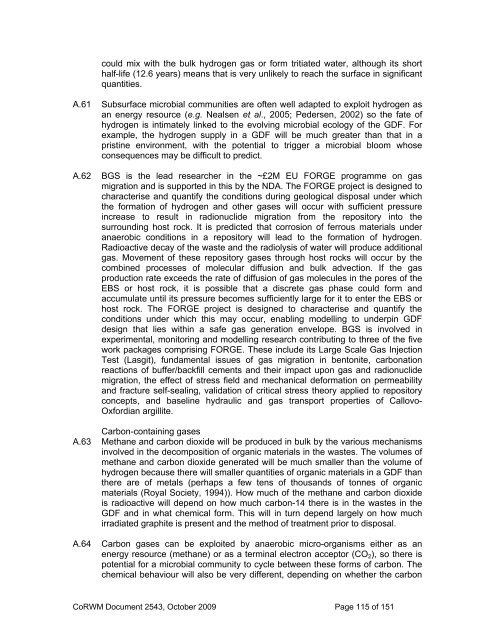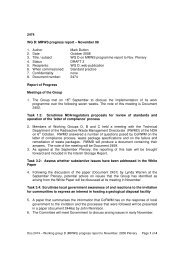2009 Report to Government on National Research and
2009 Report to Government on National Research and
2009 Report to Government on National Research and
- TAGS
- corwm.decc.gov.uk
Create successful ePaper yourself
Turn your PDF publications into a flip-book with our unique Google optimized e-Paper software.
could mix with the bulk hydrogen gas or form tritiated water, although its short<br />
half-life (12.6 years) means that is very unlikely <str<strong>on</strong>g>to</str<strong>on</strong>g> reach the surface in significant<br />
quantities.<br />
A.61 Subsurface microbial communities are often well adapted <str<strong>on</strong>g>to</str<strong>on</strong>g> exploit hydrogen as<br />
an energy resource (e.g. Nealsen et al., 2005; Pedersen, 2002) so the fate of<br />
hydrogen is intimately linked <str<strong>on</strong>g>to</str<strong>on</strong>g> the evolving microbial ecology of the GDF. For<br />
example, the hydrogen supply in a GDF will be much greater than that in a<br />
pristine envir<strong>on</strong>ment, with the potential <str<strong>on</strong>g>to</str<strong>on</strong>g> trigger a microbial bloom whose<br />
c<strong>on</strong>sequences may be difficult <str<strong>on</strong>g>to</str<strong>on</strong>g> predict.<br />
A.62 BGS is the lead researcher in the ~£2M EU FORGE programme <strong>on</strong> gas<br />
migrati<strong>on</strong> <strong>and</strong> is supported in this by the NDA. The FORGE project is designed <str<strong>on</strong>g>to</str<strong>on</strong>g><br />
characterise <strong>and</strong> quantify the c<strong>on</strong>diti<strong>on</strong>s during geological disposal under which<br />
the formati<strong>on</strong> of hydrogen <strong>and</strong> other gases will occur with sufficient pressure<br />
increase <str<strong>on</strong>g>to</str<strong>on</strong>g> result in radi<strong>on</strong>uclide migrati<strong>on</strong> from the reposi<str<strong>on</strong>g>to</str<strong>on</strong>g>ry in<str<strong>on</strong>g>to</str<strong>on</strong>g> the<br />
surrounding host rock. It is predicted that corrosi<strong>on</strong> of ferrous materials under<br />
anaerobic c<strong>on</strong>diti<strong>on</strong>s in a reposi<str<strong>on</strong>g>to</str<strong>on</strong>g>ry will lead <str<strong>on</strong>g>to</str<strong>on</strong>g> the formati<strong>on</strong> of hydrogen.<br />
Radioactive decay of the waste <strong>and</strong> the radiolysis of water will produce additi<strong>on</strong>al<br />
gas. Movement of these reposi<str<strong>on</strong>g>to</str<strong>on</strong>g>ry gases through host rocks will occur by the<br />
combined processes of molecular diffusi<strong>on</strong> <strong>and</strong> bulk advecti<strong>on</strong>. If the gas<br />
producti<strong>on</strong> rate exceeds the rate of diffusi<strong>on</strong> of gas molecules in the pores of the<br />
EBS or host rock, it is possible that a discrete gas phase could form <strong>and</strong><br />
accumulate until its pressure becomes sufficiently large for it <str<strong>on</strong>g>to</str<strong>on</strong>g> enter the EBS or<br />
host rock. The FORGE project is designed <str<strong>on</strong>g>to</str<strong>on</strong>g> characterise <strong>and</strong> quantify the<br />
c<strong>on</strong>diti<strong>on</strong>s under which this may occur, enabling modelling <str<strong>on</strong>g>to</str<strong>on</strong>g> underpin GDF<br />
design that lies within a safe gas generati<strong>on</strong> envelope. BGS is involved in<br />
experimental, m<strong>on</strong>i<str<strong>on</strong>g>to</str<strong>on</strong>g>ring <strong>and</strong> modelling research c<strong>on</strong>tributing <str<strong>on</strong>g>to</str<strong>on</strong>g> three of the five<br />
work packages comprising FORGE. These include its Large Scale Gas Injecti<strong>on</strong><br />
Test (Lasgit), fundamental issues of gas migrati<strong>on</strong> in ben<str<strong>on</strong>g>to</str<strong>on</strong>g>nite, carb<strong>on</strong>ati<strong>on</strong><br />
reacti<strong>on</strong>s of buffer/backfill cements <strong>and</strong> their impact up<strong>on</strong> gas <strong>and</strong> radi<strong>on</strong>uclide<br />
migrati<strong>on</strong>, the effect of stress field <strong>and</strong> mechanical deformati<strong>on</strong> <strong>on</strong> permeability<br />
<strong>and</strong> fracture self-sealing, validati<strong>on</strong> of critical stress theory applied <str<strong>on</strong>g>to</str<strong>on</strong>g> reposi<str<strong>on</strong>g>to</str<strong>on</strong>g>ry<br />
c<strong>on</strong>cepts, <strong>and</strong> baseline hydraulic <strong>and</strong> gas transport properties of Callovo-<br />
Oxfordian argillite.<br />
Carb<strong>on</strong>-c<strong>on</strong>taining gases<br />
A.63 Methane <strong>and</strong> carb<strong>on</strong> dioxide will be produced in bulk by the various mechanisms<br />
involved in the decompositi<strong>on</strong> of organic materials in the wastes. The volumes of<br />
methane <strong>and</strong> carb<strong>on</strong> dioxide generated will be much smaller than the volume of<br />
hydrogen because there will smaller quantities of organic materials in a GDF than<br />
there are of metals (perhaps a few tens of thous<strong>and</strong>s of <str<strong>on</strong>g>to</str<strong>on</strong>g>nnes of organic<br />
materials (Royal Society, 1994)). How much of the methane <strong>and</strong> carb<strong>on</strong> dioxide<br />
is radioactive will depend <strong>on</strong> how much carb<strong>on</strong>-14 there is in the wastes in the<br />
GDF <strong>and</strong> in what chemical form. This will in turn depend largely <strong>on</strong> how much<br />
irradiated graphite is present <strong>and</strong> the method of treatment prior <str<strong>on</strong>g>to</str<strong>on</strong>g> disposal.<br />
A.64 Carb<strong>on</strong> gases can be exploited by anaerobic micro-organisms either as an<br />
energy resource (methane) or as a terminal electr<strong>on</strong> accep<str<strong>on</strong>g>to</str<strong>on</strong>g>r (CO2), so there is<br />
potential for a microbial community <str<strong>on</strong>g>to</str<strong>on</strong>g> cycle between these forms of carb<strong>on</strong>. The<br />
chemical behaviour will also be very different, depending <strong>on</strong> whether the carb<strong>on</strong><br />
CoRWM Document 2543, Oc<str<strong>on</strong>g>to</str<strong>on</strong>g>ber <str<strong>on</strong>g>2009</str<strong>on</strong>g> Page 115 of 151



